|

A Rare Treat
Verdi's 'Aida' from Prescott,
reviewed by SUSAN HAMPTON
Ismael Pasha, the ruler of Egypt in the late nineteenth century, had built a major opera house in Cairo. He was fond of western European music and art so he wanted to bring as much of it to Egypt as he could. He hoped to be thought of as a great patron of the arts. As a result, he offered Giuseppe Verdi an exorbitant amount of money to write an opera on a work 'of a local nature' that would have its first performance in Cairo.
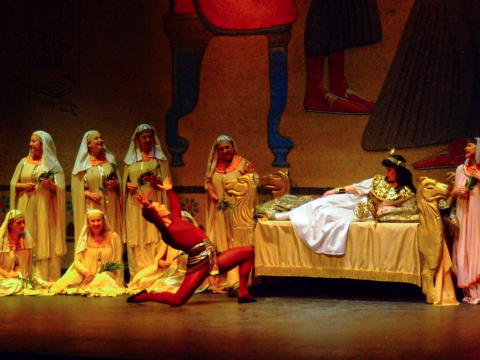
Dance for the Princess in her chamber by Ballet Arabesk. Photo © 2009 Robin Grant
|
French Egyptologist August Mariette wrote the scenario for an opera sure to be rich in local color. He sent it to librettist Camille du Locle who had worked with Verdi on Don Carlos. Verdi, fascinated with the idea of an exotic opera, had du Locle write a French prose libretto for it. Only after that did the final librettist, Antonio Ghislanzoni, turn it into Italian verse. Actually, Aida is very much a French grand opera, complete with spectacle and ballet, despite the fact that it is sung in Italian.
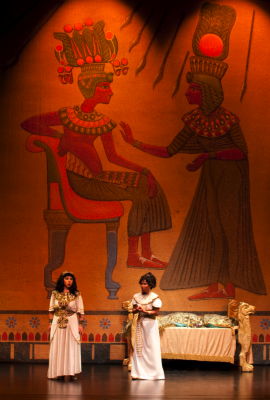
Aida (Olga Chernisheva) helps Princess Amneris (Tatyana Kaminskaya) to dress for the Triumphal Scene. Photo © 2009 Slava Mudry
|
The opera had its Cairo première, although it was delayed for almost a year because the scenery and costumes were held up by the Franco-Prussian war. Verdi, however, was far more interested in having his new opera seen at La Scala in Milan and it was first staged there on 8 February 1872. It boasted a star-studded cast that included the lady who may have been the composer's mistress, Teresa Stolz, in the title role.
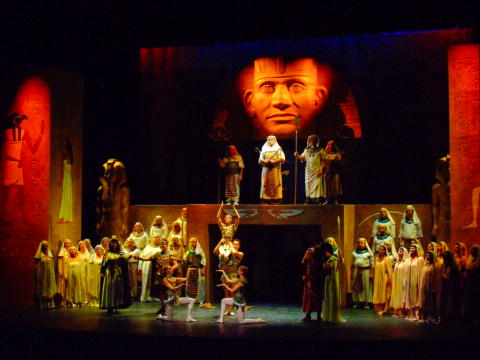
The Triumphal Scene, with dancers from Ballet Arabesk. Photo © 2009 Slava Mudry
|
Staging Aida is a huge undertaking. It requires a large orchestra and good-sized chorus along with dancers and a full complement of soloists. Few regional companies can afford to do it justice, so it was quite an amazing feat when the touring company Teatro Lirico d'Europa brought this opera in all its complexity to Prescott, Arizona, USA on 6 February 2009. It was the same show that had already received great critical approval on the East coast and would soon be enjoyed in California. The brand new traditional production by Giorgio Lalov featured structures resembling museum pieces from the age of the Pharaohs that were decorated with copies of Ancient Egyptian art, as well as attractive, well-tailored costumes.
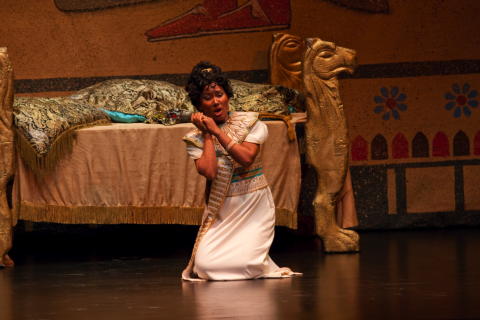
Aida (Olga Chernisheva) lamenting her position as a slave and the possible futility of her love for Radames. Photo © 2009 Slava Mudry
|
Olga Chernisheva was a poignant Aida. She has already proven to be a consummate actress and she sang with power and finesse. Russian born and American trained, she has the right sound for Italian opera. She was passionate in her duets with Rumen Doikov, her Radames, while her top notes radiated above this opera's huge ensembles. In the quieter moments, she sang with sweet resonant tones and an intimacy that made a real person of her character. Doikov was somewhat less of an actor, but he had the robust high notes that his role demanded and he was a commanding military leader.
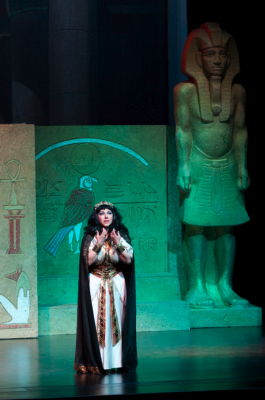
Amneris (Tatyana Kaminskaya) listens to the trial of her beloved Radames. Photo © 2009 Slava Mudry
|
Tatyana Kaminskaya who sang the role of Princess Amneris, Aida's rival for the love of Radames, has an enormous voice of great beauty and distinctive coloration. She easily surmounted the full orchestration of the Judgment Scene and her enthralling sound rolled out over the audience like the waves of an ocean. The most interesting young singer in the cast was the Amonasro, young Macedonian baritone Marian Jovanovsky. With his easily produced, sizeable dark voice and its glinting bronze overtones, he conveyed the bite of the drama.
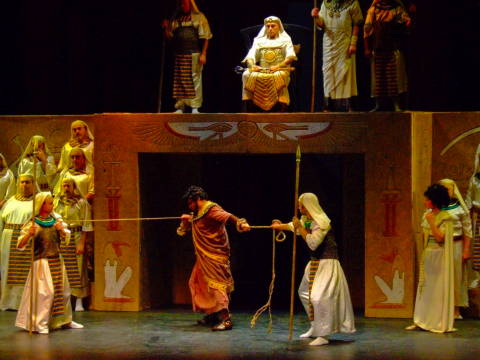
Amonasro (Marian Jovanovsky) tries to escape from the Egyptians who hold him captive. Photo © 2009 Slava Mudry
|
Vladimir Hristov was a properly overbearing king, while his high priest, Ramfis, sung by bass, Plamen Dimitrov, was menacing and dismissive of foreigners. Both of them added much to telling the details of the sad love story. Sweet voiced soprano Snejana Dramcheva offered a few moments of respite from the melodramatic story with her lovely invocation of the Egyptian gods while the Sofia Symphony Chorus, augmented with voices from a Colorado conservatory, sang with exquisite harmonies.
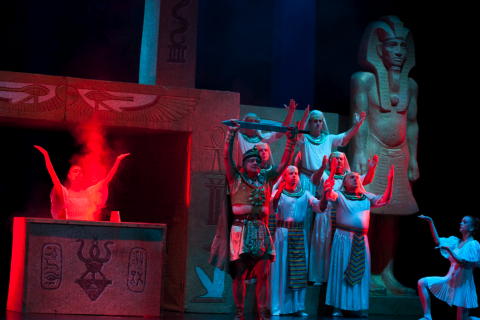
A scene from 'Aida' in Prescott. Photo © 2009 Slava Mudry
|
Krassimir Topolov conducted with brisk tempi and the Sofia Symphony played Verdi's gloriously orchestrated score with accuracy and precision. Needless to say, this excellent performance of the Verdi grand opera was a rare treat for the people of Prescott, Arizona.
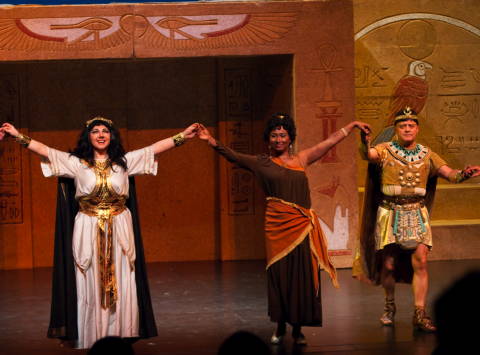
Curtain call at the Yavapai College Theater in Prescott, Arizona. From left to right: Amneris (Tatyana Kaminskaya), Aida (Olga Chernisheva) and Radames (Rumen Doikov). Photo © 2009 Slava Mudry
|
Copyright © 22 February 2009
Susan Hampton, Los Angeles, USA

|

